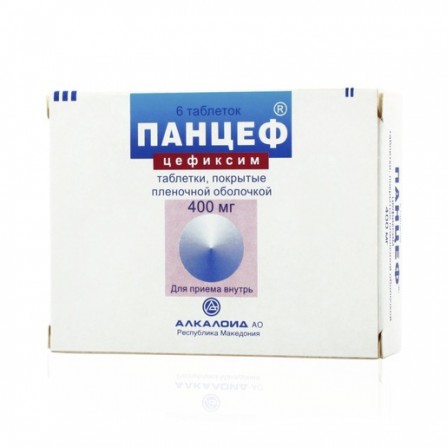Pancef 400mg N6 coated pills
Condition: New product
987 Items
Rating:
Be the first to write a review!

More info
Active ingredients
Cefixime
Release form
Pills
Composition
1 tablet contains: Active ingredient: cefixime 400 mg.
Pharmacological effect
Semisynthetic cephalosporin III generation antibiotic for oral administration of a wide spectrum of action. Bactericidal effect. The mechanism of action is due to inhibition of the synthesis of the cell membrane of the pathogen. Cefixime is resistant to β-lactamase produced by most gram-positive and gram-negative bacteria. In vitro, cefixime is active against gram-positive bacteria: Streptococcus agalactiae; Gram-negative bacteria: Haemophilus parainfluenzae, Proteus vulgaris, Klebsiella pneumoniae, Klebsiella oxytoca, Pasteurella multocida, Providencia spp., Salmonella spp., Shigella spp., Citrobacter amalonaticus, Citrobacter durs, asparanty, and asparanty, asparanty, asparanty, asparanty, asparanty, and ay ay ay a n ay ay a n ay a n a n a ry of Gram-positive bacteria: Streptococcus pneumoniae, Streptococcus pyogenes; Gram-negative bacteria: Haemophilus influenzae, Moraxella (Branhamella) catarrhalis, Escherichia coli, Proteus mirabilis, Neisseria gonorrhoeae. By cefixime-resistant Pseudomonas spp., serocigcus (Streptococcus) of the serogroup are resistant, and they are in line with the reference for the sample and the sample that is in touch with the reference for the census, and the sample, which is a part of the sample, and the sample, which is in line with the reference for the cf. (including methicillin-resistant strains), Enterobacter spp., Bacteroides fragilis, Clostridium spp.
Pharmacokinetics
When taken orally, the bioavailability of cefixime is 40-50% regardless of food intake, however, Cmax cefixime in serum is achieved by 0.8 h faster when taking the drug with food. Binding to plasma proteins, mainly albumin, is 65%. About 50% of the dose is excreted in the urine unchanged within 24 hours, about 10% of the dose is excreted in the bile. T1 / 2 depends on the dose and is 3-4 hours. In patients with impaired renal function, with CK from 20 to 40 ml / min, T1 / 2 increases to 6.4 h, with CK 5-10 ml / min - up to 11.5 h.
Indications
Infectious and inflammatory diseases caused by susceptible microorganisms: pharyngitis, tonsillitis, sinusitis, acute and chronic bronchitis, otitis media, uncomplicated urinary tract infections, uncomplicated gonorrhea.
Contraindications
Hypersensitivity to cephalosporins and penicillins.
Precautionary measures
Do not exceed recommended doses.
Use during pregnancy and lactation
Application during pregnancy is possible only in the case when the intended benefit to the mother outweighs the potential risk to the fetus. If necessary, use during lactation should stop breastfeeding.
Dosage and administration
For adults and children over 12 years old with a body weight of more than 50 kg, the daily dose is 400 mg (1 time / day or 200 mg 2 times / day). Duration of treatment is 7-10 days.With uncomplicated gonorrhea - 400 mg once. For children under 12 years old - 8 mg / kg body weight 1 time / day or 4 mg / kg every 12 hours. In infections caused by Streptococcus pyogenes, the treatment should be at least 10 days In case of impaired renal function (with CK from 21 to 60 ml / min) or in patients on hemodialysis, the daily dose should be reduced by 25%. In CK ≤ 20 ml / min or in patients on peritoneal dialysis, the daily dose should be reduced by 2 times.
Side effects
On the part of the digestive system: dry mouth, anorexia, diarrhea, nausea, vomiting, abdominal pain, flatulence, a transient increase in the activity of hepatic transaminases and alkaline phosphatase, hyperbilirubinemia, jaundice, candidiasis of the gastrointestinal tract, dysbacteriosis; rarely - stomatitis, glossitis, pseudomembranous enterocolitis. From the hematopoietic system: leukopenia, thrombocytopenia, neutropenia, hemolytic anemia. From the central nervous system: dizziness, headache. From the urinary system: interstitial nephritis. , eosinophilia, fever.
Overdose
Tubular secretion blockers (allopurinol, diuretics) delay the excretion of cefixime by the kidneys, which can lead to increased toxicity. Cefixim reduces the prothrombin index, enhances the effect of indirect anticoagulants. Antacids containing magnesium or aluminum hydroxide, slow down the absorption of cefixime.
Interaction with other drugs
Tubular secretion blockers (allopurinol, diuretics, etc.) delay the excretion of cefixime by the kidneys, which can lead to an increase in toxicity. Cefixime reduces the prothrombin index, enhances the effect of indirect anticoagulants. Antacids containing magnesium or aluminum hydroxide, slow down the absorption of the drug. With simultaneous use of cefixime and carbamazepine increases the concentration of the latter.
special instructions
It should be used with caution in elderly patients, patients with chronic renal failure or pseudomembranous colitis (in history), in children under 6 months. With prolonged use, the normal intestinal microflora may be impaired, which can lead to the growth of Clostridium difficile and cause severe development diarrhea and pseudomembranous colitis. Patients with a history of allergic reactions to penicillins, may show hypersensitivity to cephalosporin antibiotics. During treatment a positive direct Coombs reaction and a false positive reaction of urine to glucose are possible.




